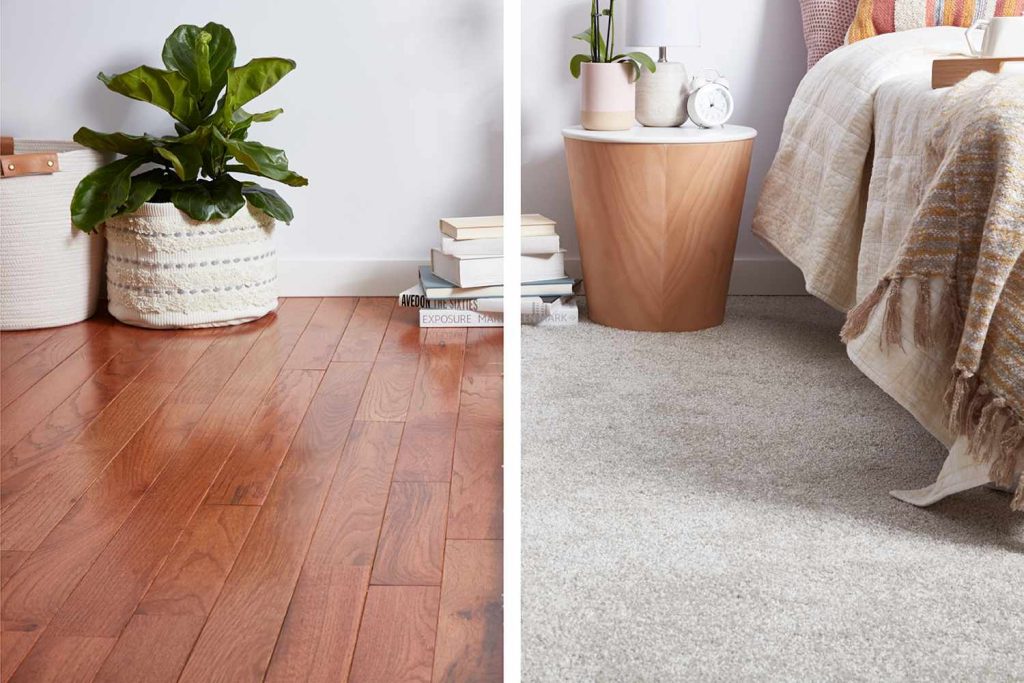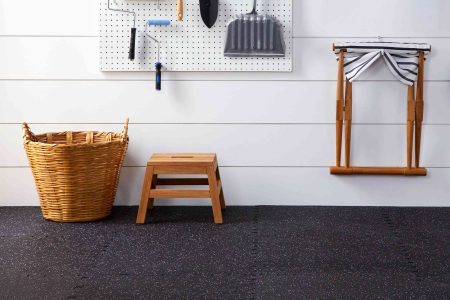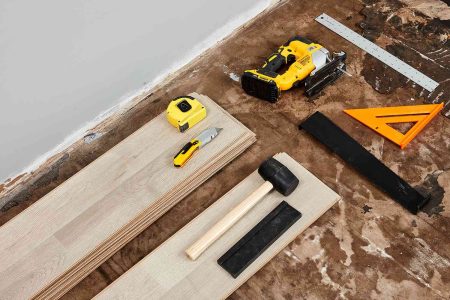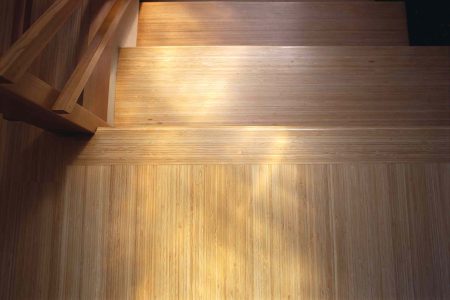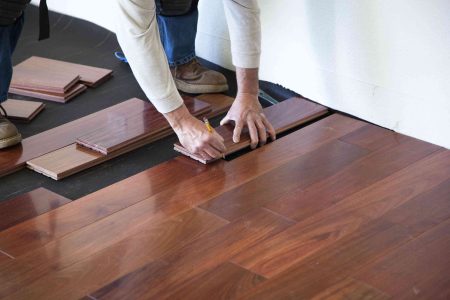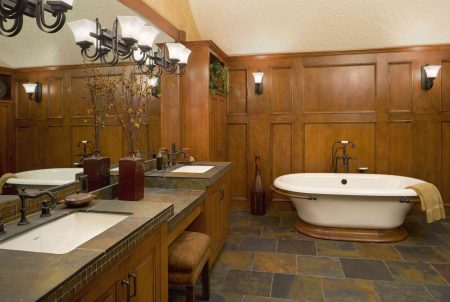Carpet and hardwood: These are two of the most common of all flooring materials, and also the two that are the most different from one another. One is an entirely synthetic, soft, quiet, inexpensive material with a relatively short lifespan, while the other is a natural, hard, and expensive flooring material that is likely to last longer than you own your home. Yet both have their roles to play, and you may well find yourself using both materials in different locations in your home. Each has a variety of characteristics that make them favorable in specific environments to match specific needs. Understanding the nature of the materials will allow you to make an informed choice about how best to use them in various locations.
Carpet vs. Hardwood Flooring
Most modern carpet is created by threading closely spaced loops of synthetic fibers through large sheets of backing material. There are some natural-fiber carpets—mostly cotton or wool—but the vast majority use synthetic materials, such as nylon to polyester. Carpeting is manufactured in huge rolls, and consumers buy it by the foot, in whatever quantities they need.
Modern hardwood flooring generally comes in one of two forms. Solid hardwood flooring is, as the name suggests, boards of solid wood that are milled from rough lumber taken from felled hardwood trees. These boards receive a smoothly sanded face on the top surface but are left slightly rough on the bottom. The edges are shaped with tongue-and-grooves that allow the boards to interlock as they are installed.
Another form of hardwood flooring is known as engineered hardwood flooring. These boards are created by adhering a relatively thin surface layer of real hardwood to a thicker (and cheaper) core layer of high-quality plywood. This construction not only makes the flooring more affordable, but it gives the boards hardwood stability against expanding and shrinking due to changing humidity levels. Most forms of engineered wood flooring have the same tongue-and-groove construction and are installed in the same way as solid hardwood flooring.
| Hardwood | Carpet | |
| Cost | Average $5 per square foot | Averages $3 per square foot |
| Durability | May last 100 years or more | Up to 10 years |
| Real Estate Value | Adds real estate value | No real estate advantage |
| Cleaning | Easy to clean with sweeping and damp mopping | Easily vacuumed, but stains are hard to remove |
| Comfort | Hard underfoot, loud and cold | Soft and warm underfoot, dampens sound |
| Appropriate Rooms | Any room except bathrooms and basements | Bedrooms, recreation spaces, dens |
| Health Considerations | Excellent for allergy sufferers | May trap pollen and dust |
Appearance
Carpet
Carpet offers more variety in terms of color, texture, and feel, but both hardwood and carpet are available in hundreds of styles to meet almost any interior design need. Carpet is not only soft to the touch but is also soft in appearance, as carpeted surfaces generally have a gentle, soft appearance within the room design.
Hardwood
The look of hardwood flooring is recognizable to anyone, and its main appeal is the natural wood-tone colors and the appealing pattern of the wood’s grain, which varies depending on the species of wood. Hardwood flooring creates a bold statement, as firm to the eye as it is to the feet.
Best for Appearance: Hardwood
Although this is largely a matter of personal preference, most people find hardwood flooring to be more attractive than carpet.
Water and Heat Resistance
Carpet
The synthetic fibers used in most modern carpets make them highly resistant to water damage, but it’s important to prevent water from seeping down into the backing layer or to the wood subfloor beneath since mold can fester down below the carpet itself. For this reason, carpet is never recommended for wet areas such as bathrooms or where spills are likely, such as in kitchens. Carpet is also easily damaged by heat, such as from burning cigarettes or hot pans. And some carpet materials can emit toxic gases if a serious home fire ignites.
Hardwood
Wood flooring is not recommended in any location where water or moisture is a constant presence, although it’s often fine in a kitchen, where spills can be wiped up immediately. Nor is most wood flooring recommended for below-grade installation against a concrete slab, since ground moisture frequently seeps up through the slab. However, engineered wood flooring may be stable enough to use in these circumstances. Hardwood can be scarred by intense heat, though mild scorch marks can sometimes be sanded out and refinished.
Best for Water and Heat Resistance: Tie
Neither carpet nor hardwood flooring are recommended for damp or constantly humid conditions, such as bathrooms or basement slabs. While carpet fibers are immune to water damage, the backing fabric can foster mold and mildew. Hardwood can easily be damaged by water. Both materials can be scorched or burned by cigarettes.
Care and Cleaning
Carpet
Routine cleaning is not particularly hard with carpet since it involves simple but frequent vacuuming. But some people feel that it is impossible to fully clean carpet because stains soak in and settle permanently and because dust and micro-bacteria are easily trapped in the fibers. Carpet is regarded as a poor flooring material for people who suffer from allergies.
Hardwood
Of the two materials, hardwood flooring is by far easier to clean. Simple sweeping or vacuuming removes loose dirt and periodic damp-mopping with a wood cleaner will remove deeper dirt and most stains.
Best for Care and Cleaning: Hardwood
Hardwood is regarded as the easier flooring material to care for since it is less susceptible to staining and doesn’t trap dust and allergens as carpet does.
Durability and Maintenance
Carpet
Routine maintenance should include frequent vacuuming, and attempting to remove stains as soon as you notice them. Occasional deep cleaning from a professional cleaning service may extend the life of your carpet, but it’s rare that a carpet will last more than a decade or so.
Hardwood
Properly maintained, hardwood flooring can last for many decades, and some of the higher-end materials can last for generations. Moreover, solid hardwood can be fully sanded down and refinished when wear becomes severe. If done correctly, most floors can be sanded three or even four times over their lifespans. Between these full-scale sanding jobs, the surface varnish should be renewed every few years. This usually involves lightly abrading the finish with a sanding screen, then applying a good-quality polyurethane varnish.
Best for Durability and Maintenance: Hardwood
Hardwood flooring holds a major advantage over carpet when it comes to durability and maintenance.
Installation
Carpet
With carpet, installers first attach an underlayment pad with staples and nail down tack strips around the edges of the room. The carpet is then rolled out over the floor, stretched, and attached around the perimeter by hooking the carpet onto the tack strips. The carpet is trimmed to a precise fit as the carpet is stretched with special tools. Seams between carpet pieces are joined with heat-activated tape placed below the seams. This is no easy process, which is why it’s rarely attempted by DIYers.
Hardwood
Hardwood flooring is usually installed by laying individual rows of boards one at a time, beginning at the longest, most visible wall. Subsequent boards are installed by sliding the edge grooves into the tongues of the preceding boards, then nailing the boards to the joists with nails or stapled driven at an angle down through the tongues. If the flooring boards are unfinished, the floor is then sanded, stained, and top-coated with several coats of polyurethane varnish. However, it’s more common these days for solid hardwood flooring to be prefinished at the factory, as is also true of all engineered hardwood flooring products. Hardwood flooring installation is usually done by professionals.
Best for Installation: Carpet
DIY installation is not common with either carpet or hardwood flooring, since both require special tools that few people own. But costs for professional installation are considerably higher for hardwood flooring.
Watch Now: 6 Tips for Choosing the Right Carpet Color
Cost
Carpet
Most carpet is considerably less expensive than most hardwood materials. And although carpeting does need to be replaced every few years, perfectly acceptable carpeting may be available for less than $1 per square foot. Costs can also run as high as $20 per square foot for the highest quality wool carpets. On average, most carpets purchased at home centers cost about $3 per square foot, installed.
Hardwood
Solid hardwood flooring costs start at around $4 per square foot and go up from there. On average, a hardwood floor costs about $5 per square foot, installed.
Best for Cost: Carpet
Carpet is a considerably less expensive flooring, but remember that you’ll likely be replacing it every 10 years or so.
Lifespan
Carpet
Carpet is generally ready for replacement in 10 years or less.
Hardwood
It’s not at all uncommon for hardwood flooring to last 100 years, and there are plenty of instances where a floor lasts through two or more homeowner generations.
Best for Lifespan: Hardwood
The life expectancy of a hardwood floor is so superior to that of carpet that it may even be the cheaper flooring over the lifetime of the home.
Sizes
Carpet
Carpeting is typically available in rolls 12 or 15 feet long, cut to whatever length the customer wants.
Hardwood
Hardwood flooring is typically sold in 48-inch-long boards, ranging in width from 1 1/2 to 4 inches wide. The thickness of solid hardwood flooring boards is usually 3/4 inches. With engineered hardwood, there is an even greater range, with planks as wide as 7 inches.
Best for Size: Tie
There is no particular size advantage to either carpet or hardwood; it depends on your preference.
Resale Value
Carpet
Carpeting usually does not add much real estate value since it is recognized as an inexpensive, short-lived flooring material. However, new carpeting will certainly be seen as an improvement over shabby old flooring.
Hardwood
Hardwood flooring commands more respect than carpeting as a design choice in residential applications. It is seen as being high-end and luxurious, both because it is a natural material and because it is much longer-lasting than carpet. Depending on the type of wood chosen and how it is finished, hardwood can create unmistakable prestige as a flooring material.
Best for Resale Value: Hardwood
Real estate professionals and prospective home buyers will much prefer hardwood flooring over carpet.
Comfort and Sound
Carpet
Perhaps the main advantage that carpet has over hardwood is its comfort. Carpet is soft and feels great beneath bare feet This is particularly soothing in bedrooms, children’s rooms, and some family and living room areas, where you want to promote an atmosphere of comfort and relaxation. Carpet is much warmer than hardwood floors, especially on a chilly winter morning. Dense carpeting with a quality bonded polyurethane padding beneath can create an R-value of 4 or more, meaning that the warmth carpeting lends to a room is very real.
The warm softness of carpet also creates a surface with excellent sound-deadening properties. With carpeting, though, the surface of the entire floor is padded and insulated so that noise won’t easily pass up or down.
The fact that carpet is so soft also makes it a particularly safe flooring choice. With hardwood, a trip or fall can result in injuries and broken objects, but carpets offer a cushioned surface throughout the room. This can be a strong consideration in homes with small children or elderly residents.
On the downside, carpet can be a poor choice for allergy sufferers, since carpets can trap dust mites and other allergens. And carpets are usually made from chemicals that may cause reactions in people who are sensitive to them. Carpet is not a “green” flooring material.
Hardwood
A major complaint about hardwood floors is that they are loud. When installed on upper levels, people below often complain that they can hear every footstep. Hardwood does hold one important comfort virtue, though. Whereas carpet can attract and hold dust and microorganisms, hardwood is easily swept or damp-mopped free of these particles, which can be troublesome for allergy sufferers.
Hardwood can also be appealing to those concerned about using green building materials. Most carpeting is made largely from refined petroleum products, which are not natural in any way. Hardwood is a natural material made from trees that can be replanted and renewed. However, when buying hardwood materials, you do want to do a little research and make sure that they are being harvested by an ecologically sound company in an environmentally friendly way.
Best for Comfort and Sound: Carpet
For immediate comfort, carpet has a clear advantage over hardwood. But homeowners dedicated to “green” building materials will put a premium on the natural quality of solid hardwood flooring.
The Verdict
By most standards of comparison, hardwood flooring is clearly superior to carpet, with better longevity, more elegant appearance, and better real estate value. But carpet can be a good choice where comfort is your primary concern, or where budget is an issue. Just be prepared to replace the carpet every 10 years or so.
Top Brands
Some companies specialize in hardwood floors, others in carpet, but a number of large flooring corporations have a good selection of both. Some of the major companies that sell both carpet and hardwood flooring include:
- Shaw: This is the biggest flooring company in the U.S., with subsidiary brands that include Daltile, Pergo, and Marazzi. They make not only hardwood flooring and carpet, but also tile and laminates.
- Mohawk: Another flooring giant, this company is best known for carpet but also manufactures a broad range of wood flooring and other flooring materials.
Carpet:
- Dupont: This very popular brand makes some of the most durable and softest carpets available. Most popular are carpets making use of the proprietary Sorona fibers.
- Stainmaster: This company is a major player in the carpet industry, with offerings for all needs and price ranges.
Wood flooring:
- Bruce: Once owned by Armstrong, Bruce is now owned by AIP (American Industrial Partners). It makes a wide range of solid hardwood and engineered hardwood flooring.
- Carlisle: This company makes unique and quite expensive wide-plank hardwood flooring.
Read the full article here



